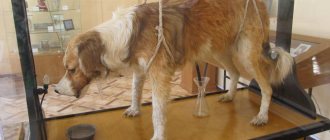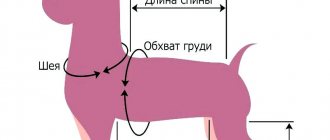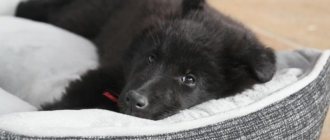A faithful, dedicated and brave dog is just a brief description of the noble St. Bernard breed, which for many centuries have been not just affectionate pets, but also brave rescuers.
History of the breed
The ancestors of the breed are considered to be Tibetan mastiffs. And for the first time, St. Bernards, as a separate breed, began to be used by monks in the 11th century to guard the shelter of travelers in the Swiss Alps.
Over time, climatic conditions changed greatly; in the 18th century, avalanches became more frequent in shelter areas, and then St. Bernards began to be used as rescuers. It became known that the dogs had a keen sense of smell, with the help of which they could find buried people under several meters of snow, and strong paws helped them stay on the slope.
The breed originally had a short, smooth coat, but in the 19th century, when winters in the Swiss mountains became much colder, monks crossed the dog with a Newfoundland to create the long-haired Saint Bernard. The breed received its first breeding registration in the same century. And in the shelter they are still breeding St. Bernards, although rescue operations are mainly carried out with the help of modern technology and lighter dogs - German shepherds.
According to the monks, St. Bernards have a special sense of smell and hearing that can sense snow danger even before it occurs. During a rescue, the dog finds a person and begins to lick his face to allow him to come to his senses and keep him conscious until the rescuers arrive, while laying his body on the victim, preventing him from freezing.
There are already real celebrities among the St. Bernards. During his 12 years of service in the monastery, a dog named Barry saved about 40 people; there is a known case when he carried a baby 5 kilometers, protecting his life. A monument was erected to the brave rescuer in France.
Who is it suitable for?
Saint Bernards are not a very active breed; despite their impressive size and extraordinary physical strength, they are not very hardy and get tired quickly after a short period of high activity.
For example, a dog can drag a heavy person at a slow speed for quite a long time, but it will not be able to run a long distance even if it is light. It's all about her size - she's not really suited for running.
St. Bernard is well suited for good-natured, open and calm people who are not particularly fond of running around. Also, its owner should not be squeamish, since the animal secretes copious amounts of saliva, which quickly spreads throughout the house.
Due to the large dimensions, the dog will most likely feel cramped in the apartment; it is best for him to have his own kennel and a small enclosure in a private house.
It is useless to use them as watchdogs due to the natural kindness of the breed. And although such a bear-like dog may terrify an inexperienced thief, in reality it most likely will not harm him, and relying on the scary effect is quite risky.
For protection, they use a modified breed of St. Bernards - the Moscow Watchdog, which is a mixture of the former with the Caucasian Shepherd.
Description of the breed
The main feature of the Saint Bernard dog breed is its impressive size.
- Weight about 100 kg.
- Height – 70-90 cm.
Initially, representatives of the breed weighed less and were a little more compact, which allowed them to easily climb peaks and dangerous slopes, and they began to gain weight only after the demand for decorative keeping of dogs.
Description of the breed:
- The head is large, the forehead is convex with obvious wrinkles;
- The eyes are set close together, with brown irises;
- The nose is wide, large with flat nostrils;
- Hanging, small ears;
- It has a strong build: a wide back with a steep loin, a strong chest. It has a wide, heavy tail, massive limbs, and large paws.
- The coat can be either soft or hard, but in any case it is thick.
Rescuer from the monastery
The St. Bernard breed is so ancient that it is hardly possible to find out for certain whose direct descendants these giants are. Experts in the field of breeding agree that their ancestors could have been Tibetan mastiffs - gigantic dogs that inhabited the lands of Central and Asia Minor back in the 4th century BC.
During the campaigns of the commander Alexander the Great, giants were brought to Greece and Ancient Rome. Later they spread throughout the territory of what is now Europe.
According to another version, St. Bernards became the “fruit of love” of mastiff-like dogs and Great Danes.
Be that as it may, the true development of the breed began much later. Switzerland is rightfully considered the birthplace of St. Bernards, where large and hardy dogs of Alpine farmers ruled the roost. In one of the previous materials, we already talked about the faithful assistants of local shepherds and cheese makers - Bernese Mountain Dogs. Our today's heroes, despite some external resemblance to the Bernese, had a completely different purpose.
Their fate was inextricably linked with the monks who lived in the monastery founded by Saint Bernard of Menton, who devoted his life to creating a shelter for wanderers and pilgrims traveling from Italy to Central Europe through the Great St. Bernard Pass. These places and climate were famous for their harsh character and frequent avalanches. Getting to your destination along steep, crumbling slopes was not an easy task, and many travelers died without reaching their goal.
As a result, local monks were forced to take on the role of not only clergy, but also rescuers. As for the large and strong dogs that lived in the monastery, at first they performed exclusively the function of guards, whom they took with them for protection from unforeseen attacks, but over time it turned out that the dogs had excellent sense of smell, which helped them accurately find people under the rubble. The animals quickly dug out the unfortunate people with their powerful paws, lay down next to them and warmed the poor fellows with their thick skin until help arrived.
In addition, it turned out that the dogs sensed the approach of an avalanche and communicated this to their owners with restless behavior.
The monks highly valued their four-legged helpers, and serious breeding work was carried out in the monastery. The first written mention of St. Bernards dates back to 1703, and the first painting depicting powerful dogs, whose physique resembled our heroes, was painted back in 1695.
This is interesting! Initially, St. Bernards were short-haired. Attempts to breed a long-haired variety were not immediately successful - snow stuck to the long hair, turning it into a heavy fur coat that interfered with normal movement.
The first furry individuals appeared from crossing with Newfoundlands. The experiment was a desperate attempt to save the stock of the St. Bernard kennel, when most of the dogs were wiped out by an unknown infection. Since the resulting dogs were unsuitable for rescue service, they were sent to guard pastures in the valleys, and only short-haired specimens remained in the mountains.
The fame of St. Bernards spread far beyond their historical habitat, and already in 1884 they acquired their own kennel club, and in 1887 a unified breed standard was approved.
These dogs came to the territory of the USSR after the Second World War and at first were used only to develop their own breed - the Moscow guard.
In the 90s, many Beethovens roamed around Russia, but due to the complex and expensive maintenance, the fashion for the breed quickly waned, and nowadays you rarely see a St. Bernard on the streets.
pixabay.com/b1-foto
Character of the breed
Saint Bernards are cute pets with a kind, easy-going disposition. They find a common language with all family members, love to play with children, despite the fact that they weigh a lot, know how to cope with their size, and behave carefully.
- The breed is smart and intelligent; its representatives are easy to educate and train, and even need them. They have a reverent attitude towards the owner, trying to be nearby and please in all demands.
- They are not only excellent rescuers, but also responsible watchmen, and often they don’t even need to do anything; thieves run away on their own at the sight of a dog. They bark extremely rarely, only when the situation really demands it.
- Saint Bernard cannot stay alone for long; he loves to be surrounded by people and other animals. If you leave your pet for a long time, depression will not be long in coming.
The characteristics of the breed are pleasing with the presence of such a number of positive qualities.
Prices for St. Bernard
On average, the cost of a puppy of this breed varies from 25,000 to 60,000 rubles. The price is determined by the quality of the pedigree, the presence of a brand, veterinary passport and other important documents. Puppies that are not sold in kennels and without a pedigree can cost around 10,000 rubles. These dogs are not suitable for breeding.
Qualified breeders sell purebred puppies at high prices to those owners who plan to participate in animal shows. This will take quite a lot of time, but can pay off if you start breeding the breed.
Coat and color
Saint Bernards are divided into two types:
- Shorthair – thick and short coat with smooth hair and a fluffier coat on the tail;
- The long-haired Saint Bernard has thick, medium-length hair, while the muzzle and ears are smooth-haired with a short coat. The tail is bushier than the rest of the body.
The coat is white with red spots; sometimes the dog can be almost entirely red or light brown. The forehead, chest, area around the nose and paws are marked with white spots. Small black markings can be observed. A Saint Bernard whose coloring has red spots on a large amount of white fur is considered a low-quality specimen.
Appearance of St. Bernard dogs
Saint Bernards are large, massive animals. A distinctive feature of its appearance is its large head with drooping lips and a melancholic look, which gives the dog a slightly sad expression. The physique is massive, the height of an adult St. Bernard at the withers can reach 90 cm. Bitches are less tall and not so powerful. The average weight of a St. Bernard is 50-70 kg, but some individuals are heavier - weighing 100-120 kg.
Photos complement the description of the appearance of representatives of the St. Bernard breed:
Head
The skull is wide, rounded. The brow ridges, the back of the head and the feet are well defined. There is a furrow running down the middle of the forehead. The muzzle is wide and does not taper towards the tip. The bridge of the nose is smooth, the lobe is large, and always black. The jaws are strong, the lips are black, the corners of the mouth are well defined. The upper lip is fleshy, forms a jowl, and covers the lower jaw.
The eyes are dark, deep-set, and medium in size. The eyelids fit tightly, but a slight sagging of the lower eyelid is allowed. The ears are medium size, fleshy, hanging. They are triangular in shape and set wide apart.
Frame
The neck is long, muscular, and has a dewlap at the throat. The physique is powerful, proportional, slightly longer than tall. The withers are well defined, the back is straight, the croup is long. The chest is deep, but not convex, the belly line is slightly tucked. The tail is strong and thick at the base. The length reaches the hock joint. When excited, the dog only lifts it slightly and can roll it into a ring.
Limbs
The limbs are straight, set parallel and wide. The bones are strong, powerful, and the muscles are pronounced. The paws are wide, the toes are tightly pressed. The dog's movements are smooth and free.
More photos to complement the description of the appearance:
Coat and colors
Now the breed has two varieties: long-haired and short-haired. The first one came from crossing with Newfoundlands. Long-haired dogs have long guard hairs that may be slightly wavy. The undercoat is dense and dense. There are feathers on the paws and tail, the head is covered with shorter hair.
Short-haired St. Bernards are more valued as rescue dogs. It is this variety of the breed that is still bred in the monastery of St. Bernard. Although the varieties differ only in the length of their coat. These dogs have a thick undercoat, the guard hair is hard and lies tightly to the body. Longer hair on hind legs and tail.
The main color of the Saint Bernard, recognized by the standard, is white and red. White spots are required on the forehead, chest, paws, tip of the tail and nape. May be present on the back. A black mask on the face is desirable. The shade of dark color can be brown, red, red, brindle.
Photos of dogs show what St. Bernards are like:
Health and life expectancy
These large dogs live short lives - only 8-10 years. Nature has not deprived St. Bernards of good health and strong immunity.
To maintain immunity, they need regular walks, but they have a lazy disposition, so you have to practically force them to get up and go for a walk.
Hip and elbow dysplasia is considered the most common in large dogs. This is a hereditary disease that is accompanied by painful sensations, and the dog begins to limp. In this case, it is necessary to urgently take the St. Bernard to the veterinarian, excluding further deterioration of the condition.
Frequent illnesses
Bone cancer is one of the most terrible and possible diseases in St. Bernards, manifested by the appearance of lameness. It can only be treated in the early stages, so you should contact a veterinarian if there are any abnormalities in walking.
The main disadvantage is the mandatory operation to cut the third eyelid, because with age it begins to grow, causing a number of eye diseases.
It is important to pay attention to the nutrition of dogs; with an unbalanced diet, the development of pyoderma is possible, and with overfeeding, bloating can occur.
Other possible diseases:
- Osteosarcoma;
- Congenital deafness;
- Heart problems;
- Epilepsy;
- Lymphoma;
- Entropion and ectropion;
- Cataract.
To avoid many problems in the future, before purchasing, you should ask for documents about the dog’s ancestors, which contain notes about the studies completed for dysplasia. It will be good if you can talk to the attending physician of the puppy's father and mother.
Caring for a St. Bernard
The Saint Bernard is large and covered with a thick layer of fur, so at temperatures above average it gets hot. The dog must be protected from overheating and direct sunlight. It’s good if you have a garden or yard with shady areas, where the dog can wait out the hottest time.
It is reasonable to assume that a dog like the St. Bernard needs exercise. But this breed is not a sprinter, but rather a marathon runner. Saint Bernard, of course, jumps and runs, but to a greater extent he requires long, leisurely walking. This trains endurance and maintains the health of the heart muscle.
This breed is prone to shedding; without regular brushing with a stiff brush, the hair will fall everywhere. Bath the dog as needed or once every 2-3 months and only with a special shampoo; sometimes it is useful to spray the dog with cool water in the heat. You cannot wash your dog with regular detergent, as this will damage the protective properties of the skin and coat.
After eating, the face should be wiped with a damp cloth; daily eye hygiene is required, as this breed is prone to ophthalmological diseases.
It is important for a St. Bernard to organize a complete diet: nutritious and balanced. The dog should not overeat and gain weight; at the same time, poor or improper nutrition will affect its health and coat condition. In warm weather, it is necessary to provide your pet with plenty of clean, cool water.
Pros and cons of the breed
Saint Bernards certainly have many advantages, but before purchasing, all the nuances, both positive and negative, are studied.
Pros of dogs:
- Friendly;
- Good guards and defenders;
- Smart, easy to train and educate;
- Get along well with people, in particular with children;
- Find a common language with other animals.
Minuses:
- It takes a lot of effort to develop a balanced diet;
- Not suitable for apartment living;
- Frequent brushing will be required during shedding;
- Increased salivation;
- Joint diseases are common.
The ideal place for a St. Bernard to live would be private houses not in the southern regions of Russia. This will allow the dog to enjoy free walking, and the owners will not be bothered by drool and hair in the apartment.
Attitude towards children and pets
Patient and gentle, they carefully let children put up with a lot. Always supervise any interactions between dogs and small children. Teach your child never to approach any dog while it is sleeping or eating, or to try to take food from it. No dog should be left unattended with a child.
They get along well with other pets, especially if they were introduced to them as puppies. However, this giant dog breed may accidentally step on or push your small pet.
Feeding ration
To ensure good health for your St. Bernard, you need to have the right diet. Due to its large weight, the dog requires a balanced diet, with additional supplements. At the same time, the number of calories is observed so as not to lead the pet to obesity and health problems. In this situation, specialized dry food can be a real salvation for the owners, but many still continue to lean toward natural nutrition, and then they will have to pay a lot of attention to the food.
Feeding the St. Bernard:
- Lean meats containing bones and cartilage;
- By-products, such as tripe (boiled only);
- For porridges, it is recommended to give rice and buckwheat. In winter, add wheat. Porridge is served separately, without any admixture;
- Vegetables and fruits are required; they can be either raw or cooked;
- The puppies are given jellied meat cooked on chicken feet, but before serving they are taken out, leaving only the broth.
- Natural fermented milk products;
- Sea (raw), river (boiled) fish.
Protein makes up a third of a dog’s diet, fiber only 5%.
How and what to feed
St. Bernards require five to six cups of dry dog food per day. It should be divided into two meals to reduce the risk of bloating. If your stomach twists, it can cut off your blood supply and require emergency medical attention.
Puppies need to be monitored and kept lean as they grow so that they do not gain weight too quickly. Adult St. Bernards can become obese, leading to a shortened lifespan and joint problems. Discuss this with your veterinarian for recommendations on feeding schedule, amounts, types of dog food, and exercise to prevent obesity.
Training
St. Bernard is very devoted to his owner, loves to follow his commands, but will only do this if he is treated well.
It is forbidden to keep a dog on a leash; this approach will make it aggressive, and there can be no talk of any kind of devotion. Training and education begin from a very early age; an adult St. Bernard cannot be influenced or re-educated. It is important to praise your pet for his small victories and encourage obedience.
From the very first days of purchasing a puppy, socialization is carried out - walks in crowded places of people and other animals in order to teach the dog to calmly react to others.
How to choose a puppy
The best place to buy a puppy is a specialized nursery. Experienced breeders will take into account the wishes of clients and offer the most suitable baby. It is better to visit several establishments and see puppies from different litters. Choosing a dog is a responsible decision. It will depend on him whether communication with your pet will bring joy or turn into a confrontation of characters.
When choosing a puppy, you need to pay attention to the following:
- physical condition and appearance: the puppy must be well-fed, have no problems with skin and fur, foreign odors, discharge from the nose and eyes;
- dog's gait;
- sociability and temperament (a lethargic and hyperactive puppy is not the norm);
- vaccination card;
- pedigree and health status of parents;
- organizing the puppies' living space;
- relationship between relatives;
- ability to go to the toilet in the right place.
It is not recommended to choose a sick puppy. This is fraught with expensive, lengthy treatment. Nothing guarantees that the owner will be able to save the baby. The early loss of a pet is a difficult ordeal. In addition, you should not encourage irresponsible, indifferent breeders who violate breeding rules and contribute to the birth of sick puppies.
Where to buy and price
Saint Bernard is a popular breed in Russia, so choosing a suitable nursery will not be difficult. You should not buy puppies secondhand or from an advertisement. There is a risk of getting a mixed breed or a sick dog. Kennels guarantee that a puppy will grow into a dog that meets physical and psychological standards.
List of nurseries:
- Gloria-Solo (Murom);
- AlpiNEN Gold (Belgorod);
- Red Guardians of the House (Chelyabinsk);
- Dog kennel House Leon (Rostov-on-Don);
- Tomsk Constellation (Tomsk);
- Amira Platinum (Moscow);
- Crystal St. Bernard (St. Petersburg).
On average, purebred St. Bernard puppies cost from 35,000 to 60,000 rubles. A dog without a pedigree costs from 18,000 rubles.
Nicknames for boys: Argus, Archie, Baron, Butler, Thunder, Marty, Olympus, Oscar, Clark, Polka, Ringo, Chuck. Nicknames for girls: Ada, Bonya, Vesta, Goldie, Dina, Sex, Sophie, Chelsea, Chessie, Elba, Emmy.
Similar breeds
The ancestors of the Saint Bernard have an ancient and complicated history, so it is not surprising that there are several similar breeds. These include:
- St. Bernard and Moscow watchdog. The Moscow watchdog has a dry, strong structure. The lips fit tightly to the teeth, not drooping. It is also easy to distinguish by the dark mask on its face. The Moscow Watchdog is used as a guard, not as a companion. Known for its activity and speed of reaction. Distrustful of strangers.
- Saint Bernard and Alabay. The breeds are very different in appearance, but have similar growth and parameters. The color of the Alabai is most often monochromatic: black, white, straw gray. These dogs are natural shepherds and guards. They have a tough character and are not suitable for the role of companions. Alabaevs cannot be kept in an apartment. What they have in common with St. Bernards is their short life expectancy and joint diseases.
- Saint Bernard and Newfoundland. Both breeds are rescue dogs. St. Bernard carries people out from under the snow rubble, Newf helps drowning people swim out. They are easy to distinguish by color: the St. Bernard is white and red, the Newfoundland is black, white, and brown. The latter is more aggressive and does not need constant communication with people. At the same time, Newfies are patient with small children. Saint Bernard is more aggressive towards its relatives. Both breeds make excellent companions.
The choice of one breed or another depends on the purpose of purchasing a dog. If a person wants to have a protective companion, he should pay attention to Newfies and St. Bernards.
Maintenance and care
- Due to its thick, thick coat, the St. Bernard feels uncomfortable in hot temperatures, so it must be kept in cold rooms; even in winter frosts, it is allowed to leave the dog overnight in an enclosure.
- A Saint Bernard in an apartment will feel uncomfortable due to its size and lack of ability to move freely, so a large private house or outdoor housing is better suited.
- The breed sheds heavily twice a year and will require intensive, frequent brushing during this period. But they rarely bathe the dog, so as not to wash away the sebum.
- The long coat will not tangle and will look good with regular brushing - twice a week.
- Saint Bernards drool, especially when eating, so it is recommended to carry a handkerchief with you to wipe your pet's mouth. The eyes also periodically water, so they require periodic wiping.
- Frequent, long walks are a must. The duration depends on the dog’s level of endurance, so that after a walk he does not collapse from fatigue. To sharpen the claws and keep the paws in good shape, it is good to walk on stones and asphalt.
Nowadays
Saint Bernards are still used today to search for people in the Alps, but this happens quite rarely.
In 2004, the Barry Foundation was founded, the main purpose of which is to raise funds for the St. Bernard nursery in the Swiss village of Martigny. Every year, about twenty puppies are born there, which go to the monastery every summer, delighting tourists with their presence. Martigny is one of the main centers of breeding work with this breed. Unfortunately, every year there are fewer and fewer St. Bernards.
Also in Switzerland, the “Association for the Protection of the St. Bernard Breed” has been created, which studies the history of this legendary breed and its popularization.
In 2009, a museum of this famous dog breed was opened in Martigny, and a stuffed Barry was brought from Bern to the opening ceremony.
Saint Bernards are still used today to search for people in the Alps, but this happens quite rarely. Helicopters are much more often used for such purposes.
After a tunnel was dug under the famous pass, traffic along it practically ceased, and the need for rescue dogs disappeared. But the Saint Bernards came down from their snow-capped mountains and settled all over the world. They may have changed in appearance, but they have not lost their loyalty, kindness and willingness to sacrifice.
Cost of St. Bernard puppies
St. Bernard puppies are common.
You can buy a dog without documents “from your own hands” for only 4,000-8,000 thousand rubles, although in this case the owner will not have a guarantee that the pet is healthy, and after a couple of months a number of health problems may “surface”. A puppy suitable for further breeding, with a good pedigree, can be purchased for 25,000-30,000 thousand rubles. And the future champion will cost no less than 45,000 thousand rubles.
Before purchasing, you need to decide for what purpose you are purchasing the puppy. With proper upbringing, a little St. Bernard can become a devoted friend and a true companion. But you should take into account its dimensions and features of content; the giant is not suitable for everyone. If the owner does not have a place where he can comfortably place a large pet, he should refuse the purchase so as not to create additional difficulties and discomfort for the dog.
Interesting facts about St. Bernards
- It is impossible to name the exact ancestor of the breed; there is a lot of disagreement on this matter. Cynologists argue to this day where the St. Bernard breed came from. It is known that the country of origin is Switzerland, but no one knows for sure which breeds were selected for selection. According to experienced dog handlers, the ancestor of the big red-and-white dogs was the Tibetan Great Dane. There is also an opinion that to breed St. Bernards, mastiffs and Great Danes were crossed.
- A special feature of St. Bernard training is the ability to work in pairs. They went in search of a person, then dug him out of the snow, after which the female remained to warm the frozen one, and the male went to people for help.
- The breed was named after the monastery of St. Bernard, located in the Alps.
- The dog breed is often found in cartoons and movies, and in leading roles. St. Bernards gained particular popularity because of the film “Genevieve,” as well as the TV series “Hopper,” and of course, who doesn’t remember the movie “Beethoven.”
- There were always dogs of this breed in the monastery, because they constantly helped to rescue people caught in a snow blockage or an avalanche. Only rough estimates indicate more than several thousand saved.
- A documented case where St. Bernard Barry helped 40 people who were captured by the elements. These were isolated cases recorded between 1800 and 1812. The dog helped them find their way to the monastery without freezing or getting lost. There was also a case when Barry carried a boy on his back for 5 km. He found the child in the snow and independently decided to take him to the people. Since that time, the most beautiful and strong puppy from the litter receives the nickname Barry. The dog rightfully deserved a monument that grateful people erected to him.
- From cartoons and movies, you can see that St. Bernards must have a barrel on their neck. There is constant controversy surrounding this “accessory”. According to the legend, brandy was poured into the container so that a person dug out from under the snow could warm up and find the strength to reach the shelter. True, it is much more prosaic, because the barrel is the fiction of Edwin Landseer. The artist painted canvases with alpine landscapes and handsome St. Bernards, and a small barrel became their highlight.
- However, today, St. Bernards do not go to work empty-handed. Not with a keg, of course, but with a modern first aid kit and a small supply of provisions and water.
- Huge and at first glance scary St. Bernards, but in fact not at all aggressive. In the “kindest breed” category, they can easily count on a prize. Aggression on the part of a St. Bernard is a very rare occurrence.
- Due to the characteristics of the breed, they grow very quickly, but remain playful like a puppy long after they grow up. Even a very large dog can behave “like a child.”
- A significant disadvantage of the breed is its short life expectancy compared to other breeds. Even with excellent care and good health, St. Bernards rarely live to the age of 9-11 years.
- If you need a versatile dog, then the St. Bernard will be the ideal choice. He can become an assistant, a friend and a good listener. The Saint Bernard will reliably protect the house, and if necessary, can save the life of its owner.
If you decide to get a dog, then get ready for the following: you will often have to clean up little mistakes after your puppy; investments will be required in annual vaccinations, feeding, toys, ammunition, etc.; any animal requires attention and communication, so if you don’t have time, then there will be no mutual understanding with the St. Bernard puppy. Big changes are coming in your life. If you can handle this, you will find a loyal friend for life. Character of St. Bernard: who is better to take a bitch or a dog
Saint Bernard The character of a dog depends on heredity and breed characteristics, but proper upbringing and training is also of no small importance. In the article... Read more
Saint Bernard color
St. Bernard Color is a canine term that refers to the color of a dog's coat. It is one of the most important traits in breeding... Read more
Training and education of St. Bernard
Saint Bernard Raising a dog is about developing correct behavior. This is the basis for successful training. Training is a set of activities aimed at… Read more
St. Bernard diseases
Saint Bernard Each breed of dog has a predisposition to certain diseases. We have collected information about typical diseases of the breed. Remember the symptoms of the disease, the risk... Read more
Saint Bernard
St. Bernard Barry and his history
The most famous Saint Bernard dog is undoubtedly Barry. It is believed that this dog saved about forty people throughout his life, although this figure differs in different sources. Barry's nickname comes from the German word "Bäri", which means bear. This is how black dogs are often called in Germany and Switzerland.
Photo by: John_Kroll. Barry had several monuments erected, the most famous of which is the Parisian one.
Barry's most famous feat is the rescue of a peasant boy caught in an avalanche on a pass. It was this incident that inspired many artists and poets, and it also became the basis for the sculptural composition of the famous monument to this dog.
According to legend, after an avalanche, Barry discovered a dying boy who was unconscious in a small cave. The dog began to lick him, and then dragged the child towards the people. When the boy regained consciousness, he climbed onto the back of the animal and was thus taken to the monastery. The monks came out and gave him to his parents. According to another version, the avalanche that almost killed the child took the life of his mother.
The Dogs of Saint Bernard
In the 11th century, on one of the Alpine passes connecting the roads of Switzerland and northern Italy, the monk Bernard from Menton decided to found a monastery and retire there from the bustle of the world. In the monastery, any traveler following this route could find shelter and food.
To say that the place chosen by Bernard for the monastery was “inhospitable” means to say nothing: the pass was at an altitude of 2472 meters, it was extremely difficult for transitions, and bad weather raged here for most of the year (8 months). Need I say that in winter the St. Bernard Pass turned into a disastrous place? At this time of year, the temperature often dropped to -35 degrees, and snowstorms and blizzards took the lives of unwary travelers. To go astray here meant inevitable and painful death.
Since the 17th century, monks from the monastery of St. Bernard (he was canonized after his death) have been breeding a breed of dogs capable of finding a person under a snowdrift or during a blizzard. The first written mention of dogs living with monks dates back to 1707. Thanks to the finds of skulls and bones, it is known that two different types of dogs were kept in the holy monastery. Animals that were used to search and rescue people were called herding animals.
These animals were smart and strong, they were not afraid of frost and blizzards, and their keen sense of smell helped them find a person covered in snow and navigate the mountains perfectly. It is known that dogs from Saint Bernard were able to sense the approach of an avalanche and warn their owners about it. The animals were strong enough to dig out a person buried even under many meters of snow.
Centuries-old traditions
Since the death of the dog in the monastery of St. Bernard, one of the animals is always named Barry - this has now become a tradition.
According to information from other sources, the woman’s name was Maria Vinzetti: with the last of her strength she tied her son to the back of a dog, which was able to pull the boy out to the people. What actually happened is unknown, but the fact remains: the dogs from Saint Bernard really saved thousands of people on that pass, among whom, of course, were children.
Another beautiful legend is associated with the death of the famous dog. According to it, the monks received a message that a soldier from Switzerland was lost in the mountains. According to another version, he was a deserter from Napoleonic army who fled to Italy. There was practically no chance of finding him alive, but Barry went in search of him. A few days later, the dog found a man completely covered in snow. St. Bernard dug up the victim, there was still life in him, but he was very bad. The dog began to lick the man's face, trying to bring him back to life. The man regained consciousness and was very frightened when he saw a huge beast above him. The soldier hit his savior with a bayonet (there are versions with a knife and also an ice pick) and seriously wounded him.
There are different versions about further events: according to one of them, the dog died on the spot, and according to another, the dog, bleeding, managed to crawl to the monastery and soon died. Following the bloody trail, the monks found the soldier and still saved him. There is also a version according to which Barry does not die from the treacherous blow, but lives out his days outside the walls of the monastery.
However, according to official data, in his declining years the dog went to a monk in Bern, where he died at the age of 14 of natural causes.
The body of the famous dog was buried, and the skin was given to the Berne Natural History Museum, where it was stuffed. It should be said that during its manufacture the real dimensions of the animal were not preserved: the stuffed animal is taller than that of a dog, and the shape of the dog’s skull was probably changed. The Scarecrow was ordered to make the image of Barry kind and meek, which he did quite well.











